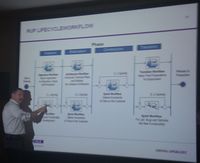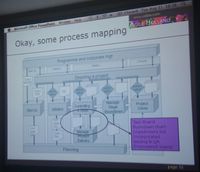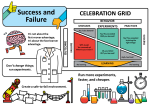A number of people, including some at the Project Management Institute, think that project success…
Iterate Your Flawed Models
I recently came across the Top 15 Worst Logo FAILS ever. It lists a number of logo designs that, in all their innocence, invite all kinds of associations with some not so innocent human behaviors. I laughed so hard that part of my brain was dangling from my nose. I suppose it is proof of my wicked mind that I immediately recognized the problems in all logos.
Unfortunately, a lot less funny was someone’s comment that my six-eyed monster, which I designed as an illustration for my upcoming book, looks suspiciously phallic in nature. Despite having a wicked mind, I had never noticed this myself. But now that the association has been mentioned, I am unable to get it out of my brain. I just cannot laugh hard enough about it.
At a recent Agile Holland event two other flawed designs were presented and discussed with the audience. One of them was RUP, and the other was PRINCE2.
 The RUP model is flawed because it invites associations with the waterfall process.
The RUP model is flawed because it invites associations with the waterfall process.
The design (I apologize for the unsharp photo) clearly suggests that the RUP process starts with n iterations of specification. And there are no frequent releases in this model, because a release into production (as suggested by this model) only happens in the last phase, after everything else is finished.
 The PRINCE2 model is flawed because it invites associations with Big Upfront Process Design.
The PRINCE2 model is flawed because it invites associations with Big Upfront Process Design.
The model depicts lots of process boxes, and they all have arrows leaving and entering them. (Note: the picture I took here is the simplified version.) Such a design makes it hard for people to see that they are allowed to pick and choose their own elements from PRINCE2, because if they do they end up with many arrows dangling from boxes that go nowhere.
Now, don’t get me wrong. The intentions of the creators of all these models were good. The Arlington Pediatric Center never intended to be a seen as a pedophilic center. Martie the Management Model never hoped to be seen as a male, six times over. And the RUP and PRINCE2 designers never wanted to suggest that you should create a big waterfall-like process upfront.
All models are wrong. Some are useful.
And some are just badly drawn.
As the designer of a logo, illustration, or process model, it is hard (if not impossible) to predict what people will recognize in your designs. You cannot easily peek into the devious and twisted minds of your viewers. It is easiest just to show them what you’ve designed. Let them have a good laugh. And then try again.
As I will.
Jurgen is an experienced author, trainer, and speaker. Why don’t you hire him to add some spice to your company event or seminar?
 Twitter –
Twitter –  Subscribe –
Subscribe –  Newsletter –
Newsletter –  LinkedIn –
LinkedIn –  SlideShare
SlideShare
| Latest, greatest and favoritest posts: If You Want Something Done, Practice Your Patience About Project Success and Failure I Follow My Rules, You Follow Yours |




